
Top 25 Rankings 1901-1935
1926 National Championship
Home
1926
College Football Top 25
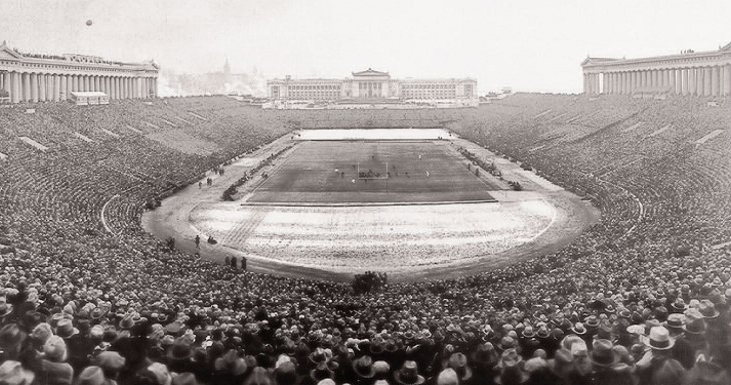
Pictured
above is one of the greatest games in college football history, 9-0
Navy taking on 7-1 Army before an estimated 110,000 fans at the
dedication game for Chicago's Soldier Field. A dramatic back and forth
contest ended in a 21-21 deadlock, but Navy was widely considered to be
the national champion anyway, because 8-0 Notre Dame was shocked 19-0
at Carnegie on the same day, one of the biggest upsets in college
football history. Notre Dame's coach, Knute Rockne, was at the
Navy-Army game.
The contenders for the 1926 MNC, aside from 9-0-1 Navy and 9-1 Notre
Dame, were 9-0 Lafayette, 10-0-1 Stanford, and 9-0-1 Alabama. I
summarized
all
of these teams and compared them in detail in my 1926 national championship article.
As I concluded there, only 9-0-1 Navy and 9-0 Lafayette are
viable
choices for #1, and an AP poll would certainly have rated Navy higher,
and almost certainly #1, so Navy will take the top slot of this hypothetical
1926 AP poll top 25. Lafayette, as a mid-major, would have barely made a top 5.
#2: Lafayette vs. Notre Dame vs. Michigan
9-1
Notre Dame would have been rated #2 by a post-bowl AP poll for 1926, even
though they took an upset loss and 9-0 Lafayette didn't. Fair? Notre
Dame lost at 7-2 Carnegie (will be rated #12) 19-0, and Carnegie lost
17-6 to Washington & Jefferson (7-1-1, #11), and Washington &
Jefferson lost 16-10 to Lafayette.
But Notre Dame played a much tougher schedule than Lafayette did.
For one thing, Notre Dame played 8 major teams, while Lafayette played
2 major teams, and Notre Dame played 5 road games to Lafayette's 3.
Notre Dame defeated 7-1-1 Army (will be #4), 8-2 Southern Cal (#8), 7-1
Northwestern (#10), and 5-3 Minnesota (#18). And all of those games,
plus the upset at Carnegie, were on the road. Notre Dame defeated twice
as many rated teams as the number of major teams Lafayette played at
all! Still, both of the major teams Lafayette played were top 25 caliber: 7-1-1 Washington & Jefferson (#11) and 5-2-2 Pittsburgh (#13).
I would be inclined to rate Lafayette higher than Notre Dame
myself, but Notre Dame's much tougher schedule, and greater
accomplishments that came with it, give reason for the hypothetical AP
poll voters of 1926 to go with Notre Dame.
7-1
Michigan would have been rated #3 by a post-bowl AP poll for 1926,
and their case against Lafayette is much stronger, because they did not
take an upset loss. Michigan's only loss came at #1 Navy. And like
Notre Dame, Michigan played a schedule that was well beyond that played
by Lafayette. Michigan notched 7 wins against major opponents, and 5 of
those were against strong teams:
7-1 Ohio State (#9), 2 games against 5-3 Minnesota (#18), 6-2 Illinois
(#19), and 5-2-1 Wisconsin (#26-38). So Michigan being rated higher
than Lafayette is certainly viable.
However, Notre Dame being
rated higher than Michigan is a problem, since Notre Dame took an upset
and Michigan did not, and though Notre Dame's schedule may have been
tougher than Michigan's, the difference is not enough to dismiss the
fact that Notre Dame lost 19-0 at #12 Carnegie. The argument for Notre
Dame would be that they defeated Army (will be #4) and Southern Cal
(#8), 2 teams that were better than anyone Michigan defeated. The Army
win was particularly compelling, since Army tied Navy, who beat
Michigan 10-0. Furthermore, Notre Dame won 20-7 at Minnesota, and while
Michigan beat Minnesota 20-0 at home, they beat them just 7-6 on the
road.
On the other hand, Michigan's 20-0 win over Minnesota came
the week after Notre Dame beat them, early in the season, and therefore
makes for a better comparison. The 7-6 win was the season finale, by
which time Minnesota was rolling, having won their previous 4 games by
an average score of 51-4. And Notre Dame may have defeated 2 opponents
who were better than any Michigan defeated, but Notre Dame played 5
strong teams, and only 2 were played consecutively, while Michigan
played 6 strong teams, and all 6 in a row with no week off in between.
So Notre Dame's advantage in schedule ends up slight, if we grant an
advantage at all. But the difference between losing to the #1 team by
10 and losing to the #12 team by 19 is far more than slight. Notre Dame
may have had the better team, and possibly the best team in the nation,
but there's just no excuse for the upset they took.
Michigan #2, Notre Dame #3.
It should be noted that it would be viable to rate Notre Dame ahead of
Michigan if Army was also rated ahead of Michigan, and I considered
that option. However, I believe that Michigan would have been much
closer to Notre Dame in a 1926 AP poll than to Army (in poll points),
and Army only defeated one strong team (Michigan defeated 5), so I'm going with
Michigan > Notre Dame > Army rather than Notre Dame > Army
> Michigan.
#4: Lafayette vs. Army vs. Stanford
#4 in a
post-bowl AP poll for 1926 would have been a close race between 9-0
Lafayette, 7-1-1 Army, and 10-0-1 Stanford. Army lost 7-0 to #3 Notre
Dame and they tied #1 Navy in their finale, so they actually had the
best relevant record of these 3
teams, despite having the worst-looking straight record. Also, I do
think that they are the likeliest team of these 3 to have ended up #4
in a 1926 AP poll. Their game against Navy was by far the biggest and
most widely covered game in college football this year, and getting the
tie was likened to a huge win for Army, since Navy was widely
considered this season's national champion.
As a mid-major, Lafayette just did not get nearly the attention
that Army got. As for Stanford, they would certainly have been rated
higher than Army at the end of the regular season, when they were 10-0,
and they might have even been #1 over Navy, but their Rose Bowl tie
with Alabama would have sent them tumbling back in a post-bowl poll
(the South was very weak this year, and though Alabama was 9-0, they
would likely have been rated about #10, at best, prior to the Rose
Bowl). So we'll place Army ahead of both Lafayette and Stanford.
It's
tough to say whether Lafayette or Stanford would have been ranked
higher in a post-bowl AP poll for 1926, but this much is clear:
Lafayette was 9-0, and Stanford took a Rose Bowl tie against a team
that would definitely have been rated behind Lafayette. And unlike
Notre Dame and Michigan, Stanford did not play a schedule that was
significantly tougher than Lafayette's. And finally, Lafayette
performed better than Stanford, as they had no close wins over unrated
teams, while Stanford barely beat 0-5-1 Olympic Club 7-3.
Army #4, Lafayette #5.
#6: Stanford vs. Alabama
This one is
easy. Though 10-0-1 Stanford and 9-0-1 Alabama tied each other in the
Rose Bowl, there is no question that Stanford should be ranked higher,
and they definitely would have been in a 1926 AP poll. Stanford
defeated 2 strong teams, including a big win at Southern Cal (will be
ranked #8), and Alabama defeated 1 strong team, and though that team,
Vanderbilt, was 8-1, they just did not compare to Southern Cal (and
will not quite make this top 25). Stanford also thoroughly dominated
Alabama in their Rose Bowl game, except, of course, on the scoreboard.
Stanford outgained them 311 yards to 92, but Alabama blocked a punt to
set up a late touchdown to get the tie.
Stanford #6, Alabama #7.
#8: Brown vs. Ohio State vs. Northwestern vs. Southern Cal
Though the order
is anyone's guess, I think the next 4 teams in a 1926 AP poll would
have been 9-0-1 Brown, 7-1 Ohio State, 7-1 Northwestern, and 8-2
Southern Cal. Of these teams, Brown is very easy to eliminate from the
race for #8, since they took an upset tie, and the other 3 teams were
not upset. Brown was tied by 5-2-2 Colgate (will be ranked #15) at home
in their finale. Moreover, Brown did not beat any good teams, and in
fact they did not beat a single winning major team. Brown is not only
not a viable candidate for the top 10, but they compare poorly to
several Eastern teams coming in next, such as Washington &
Jefferson, Carnegie, Pittsburgh, and Georgetown. As such, I'll put off
discussing Brown further until I'm done ranking those teams, and get to
Colgate.
Ohio State, Northwestern, and Southern Cal all had the same
relevant record, Ohio State losing only to #2 Michigan, Northwestern
losing only to #3 Notre Dame, and Southern Cal losing only to #3 Notre
Dame and #6 Stanford. Ohio State defeated 6-3 Columbia (#26-38) and 6-2
Illinois (#19), Northwestern defeated 5-2-1 Purdue (#26-38), and
Southern Cal defeated 6-1 Washington State (#23) and 7-1 Oregon State
(#22). Obviously, OSU and USC separate themselves a bit from
Northwestern there. As far as performance goes, USC won all of their
games by more than a touchdown, whereas Ohio State edged 3-4 Wilmington
13-7, and Northwestern struggled past 3-5 Iowa 13-6 in their finale. On
that slim basis, I'm giving USC the nod for #8, and OSU gets #9 because
they beat 2 strong opponents, one of them rated, and Northwestern just
beat one strong but unrated opponent. And Ohio State likely would have
been rated higher than Northwestern anyway.
Southern Cal #8, Ohio State #9, and Northwestern #10.
Illinois, Pennsylvania, Cornell, and Princeton
6-2
Illinois, 7-1-1 Pennsylvania, 6-1-1 Cornell, and 5-1-1 Princeton would
have been next in line in a 1926 AP poll, but they all would have been
overrated. These were all big-name schools at the time, and that plus
nice looking straight records had them overvalued.
Much like in the top 25s I did for 1927 and 1928,
Illinois was not as strong as people seemed to think they were, or at
the least, their schedule and performance were both weak in all of
these seasons despite nice straight records. Their only losses came to
#2 Michigan and #9 Ohio State, and they only lost to OSU 7-6 in their
finale, a great result, but it was their best one, and it was a loss.
They struggled to beat 3-5 Iowa 13-6 and 2-6 Chicago 7-0, and the only
winning major team they defeated was 7-1-1 Penn, and that by a mere 3-0
at home. And Penn wasn't all that great themselves...
Penn's tie
came to 6-1-1 Cornell at home in their finale. And Cornell's loss came
17-9 at 6-3 Columbia (who will fall just outside this top 25, #26-38).
Cornell did not beat a major winning team, and they were weak in wins
by 6-0 over Geneva (8-3) and 24-23 over Dartmouth (4-4). Cornell should
be rated behind 6-3 Columbia due to their loss to them, which is to
say, out of the top 25 entirely. Penn beat Columbia 3-0 at home, and by
that slim margin, they earned a spot in the top 25 despite the tie to
Cornell, but that spot belongs lower on this list than #11-14. 7-2-1
Syracuse, who will be rated #15, beat Columbia 19-2 on the road.
As
for 5-1-1 Princeton, they were not even remotely ratable. They lost to
#1 Navy by 14 points, and while that may look fine, Navy was not
exactly a juggernaut. Five teams came closer to Navy than that, and one
of those teams, 5-2-1 Purdue, will not quite make this top 25.
Princeton was also tied by 4-3-2 Washington & Lee, an awful result,
and they had multiple other weak performances: 14-7 over 6-1-1 Amherst (a minor team), 7-6 over 1-8 Lehigh, and 10-7 over 4-4 Yale. And all of those games were at home.
Illinois
compares unfavorably to 5-3 Minnesota, so I'll put off discussing them
henceforward until I get to Minnesota. Penn will have to come in behind
Illinois, having lost to them, and Cornell and Princeton are hereby
banished from top 25 consideration altogether.
Washington & Jefferson, Carnegie, Pittsburgh, and Georgetown
Here we have a more worthy quartet of teams to consider for spots #11-14: 7-1-1 Washington & Jefferson, 7-2 Carnegie, 5-2-2 Pittsburgh, and 7-2-1 Georgetown.
7-1-1 Washington & Jefferson lost a close game to 9-0 Lafayette
(#5), they tied Pitt, and their big win came 17-6 at Carnegie. They
also won 13-3 at 6-4 West Virginia, and all of their wins came by more
than a touchdown. 7-2 Carnegie's other loss came 6-0 at 8-1 NYU (will
be rated #21), but they made up for that one with the huge 19-0 win
over #3 Notre Dame. They also defeated Pitt 14-0 and West Virginia 20-0.
Pitt's
5-2-2 record doesn't look like much, but their schedule was rough. The
losses came to 9-0 Lafayette (#5) and to Carnegie, and they tied
Washington & Jefferson and Georgetown. They defeated 5-2-2 Colgate
(will be #15) and West Virginia. Georgetown was the only team here that
did not beat 6-4 West Virginia:
they lost to the Mountaineers 13-10 at home. Their other loss was an
extremely close 10-7 affair at 9-0-1 Navy (#1), and they tied
Pittsburgh. Their big win came 13-7 at 7-2-1 Syracuse (will be #15).
The order of ranking is pretty straightforward for these teams.
Washington & Jefferson beat Carnegie, who beat Pitt. Pitt and
Georgetown tied, but Pitt tied Washington & Jefferson (a higher
ranked team), and Georgetown took an upset loss to West Virginia, who
will be unrated here.
Washington & Jefferson #11, Carnegie #12, Pittsburgh #13, and Georgetown #14.
Brown, Colgate, and Syracuse
9-0-1 Brown tied
5-2-2 Colgate, who tied 7-2-1 Syracuse. I spent a lot of time looking
at these 3 teams, and in the end the easy thing to do is to just place
them into a 3-way tie for #15. So I'm going to do the easy thing.
As discussed earlier, 9-0-1 Brown didn't beat any winning major
teams, they barely beat 4-4 Yale, and they tied Colgate at home in
their finale. Like Pittsburgh, Colgate was better than their 5-2-2
record might indicate. They lost 19-16 at 5-2-2 Pitt (#13), and they
outplayed 9-0-1 Navy (#1) but lost 13-7 on a late miracle play. Their
tie with Syracuse was on the road, and all of their wins were
dominating (average score 35-1). They certainly performed better than
Brown did, and should be ranked ahead of Brown, but I think I can give
the hypothetical AP poll voters of 1926 a tie here.
7-2-1 Syracuse lost 13-7 to Georgetown (#14) and 27-21 at Army
(#4), the latter a terrific performance. They won 10-0 at 5-4 Penn
State and 19-2 at 6-3 Columbia (#26-38). Penn, coming in below, won by
a mere 3-0 over both Penn State and Columbia, both games at home, and
Illinois, also coming in below, only beat Penn 3-0 at home. Syracuse
should also be rated higher than Brown, but again, this tie represents
a compromise between logic and the preferences of 1926 football writers.
Brown, Colgate, and Syracuse all share slot #15.
Brown
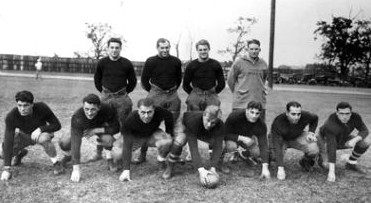
 Brown
and Columbia are the only schools now in the Ivy League that never won
a mythical national championship. Brown tended to be strong until World
War I, but they rarely threatened to be best in the land. They were more
of a #15 type team, going 98-52-6 against fairly rigorous schedules
1902-1917.
Brown
and Columbia are the only schools now in the Ivy League that never won
a mythical national championship. Brown tended to be strong until World
War I, but they rarely threatened to be best in the land. They were more
of a #15 type team, going 98-52-6 against fairly rigorous schedules
1902-1917.
They were first taken seriously 1909-1911 behind the
services of Hall of Fame quarterback Earl Sprackling, a consensus All
American in 1910. That year, Brown went 7-2-1 with a 21-0 win at 6-2-2
Yale, their first victory over Yale in 19 tries. Sprackling kicked 3
field goals, hit 5 of 6 passes for 180 yards and a touchdown, and totaled 456 all-purpose yards.
Brown appeared in the Rose Bowl
following the 1915 season, losing to Washington State, but they
finished just 5-4-1 and were not a top 25 caliber team that year. Brown's
greatest season ever, and the one time they did threaten to be best in
the land, was the following year, 1916. They started out a dominating 8-0, including
victories over 8-1 Yale and 7-3 Harvard, and an MNC appeared to be in
the bag, but they were crushed 28-0 by Colgate in their finale. The
star of this Brown team was Hall of Fame halfback Fritz Pollard, but 2
other Brown players made first team AA lists in 1916. Brown football
pretty much disappeared after 1917, and the school has fielded just 3
top 25 caliber teams since then.
The coach in 1926, in his first
season here, was Hall of Famer Tuss McLaughry (pictured at left). He
went an anemic 76-68-5 at Brown 1926-1940, then a poor 44-58-3 at
Dartmouth over 12 years. His total at 4 schools was 143-149-13,
rendering him the only coach in the Hall of Fame with a losing record.
Brown had a pair of nonconsensus AA in 1926, end Harold Broda and
quarterback Roy "Red" Randall. This team became famous as the "Iron
Men," because the starting 11 played all 60 minutes in a 7-0 win over
Yale, and then they did the same the next week in a 10-0 win over
Dartmouth. The tie with Colgate in their finale was a heartbreaker, not
just because a perfect season was spoiled, but because they had so many
chances to win in that game and couldn't get the job done. Halfback
Dave Mishel, who had kicked a field goal earlier in the game and who
had not missed an extra point in 16 tries, failed to connect on 3 field
goal attempts in the 4th quarter. Pictured below is an easy straight-on attempt
clonking off an upright.
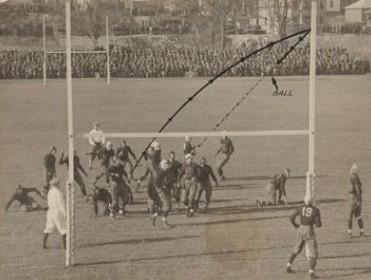
So
Colgate had spoiled a perfect Brown season in 1916 and 1926, and they
would do it again in 1932. That year, Brown beat 7-1-1 Columbia and
started 7-0, but 9-0 Colgate routed them 21-0 in their finale. Brown
finished 7-1, had another pair of nonconsensus AA, and I have them
ranked #9 for that season. It is the last top 25 caliber team they ever fielded.
Syracuse
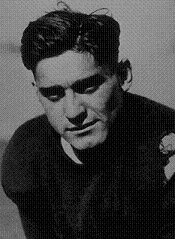
Syracuse
was a step behind Brown 1901-1916,
fielding top 25 caliber teams 9 times, usually #21-25 type teams. But
they were significantly better than Brown 1918-1926, and fielded top 25
teams in almost all of those years, going 71-16-7. After this
season, Syracuse largely disappeared for a few decades, and only
fielded 2 more top 25 teams
until the 1950s.
The coach this season was Pete Reynolds, a
Syracuse grad who was only around for 2 years, going 8-1-1 in 1925 and
7-2-1 this year. He ended up 77-58-14 at 5 schools. The star of the
team was consensus All American end Vic Hanson (pictured above), who
was also All American in basketball 3 straight years 1925-1927. He
became head coach of his alma mater 1930-1936, going 33-21-5. He is in
the football and basketball Halls of Fame.
1918-1926 was
probably Syracuse's strongest period in school history, but after a
long coma, they awakened again under Hall of Fame coach Ben
Schwartzwalder in the 1950s, culminating in the school's only MNC in
1959. They made the fixed AP poll 12 times 1952-1967. Then they went
into a 20 year coma, awakening again for a decent stretch 1987-1998 (6
top 25 finishes in 12 years). They've been in a coma again since 2001
as of this writing.
Minnesota, Illinois, and Pennsylvania
Minnesota might not have been ranked in a 1926 top 25 at all due to their 5-3 record:
this season was very deep in great football teams. But they probably
would have made it, especially since they lost to Michigan (7-1, #2) by
just one point in their finale, and I just can't see
Minnesota being ranked behind Illinois, so I'm moving the Gophers up as
I drop the Illini down. Minnesota's losses came to #3 Notre Dame and
twice to #2 Michigan. They won 16-10 at 5-2-1 Wisconsin (#26-38) and
blew out everyone else they played (average score in those games 60-2).
Illinois' one big win was 3-0 over 7-1-1 Pennsylvania at home, and they
struggled to get by 2-6 Chicago 7-0 and 3-5 Iowa 13-6 (Minnesota beat
Iowa 41-0 on the road).
Minnesota #18, Illinois #19, and Pennsylvania #20.
New York, Oregon State, Washington State, and Washington
8-1 New York
comes in next because this is about where an AP poll would have placed
them, and that works fine. They performed impressively this season, but
their schedule was weak, and they only played 2 tough games. In those
games, they beat 7-2 Carnegie (#12) 6-0 at home, and they lost 15-7 at
6-2 Nebraska (will be ranked #25) in their finale.
Similarly, this is about where 7-1 Oregon State, 6-1 Washington State,
and 8-2 Washington would be ranked. OSU and WSU both took their one
loss to #8 Southern Cal, but OSU would have gotten the ratings edge
over WSU because they traveled across the country to beat 6-3 Marquette
29-0. OSU also had just 1 close win, while WSU had 4.
8-2
Washington took their losses to #6 Stanford and Washington State. Their
big win came 10-6 over 6-2 Nebraska at home (will be ranked #25).
New York #21, Oregon State #22, Washington State #23, and Washington #24.
#25: Vanderbilt, Haskell, St. Mary's (California), Southern Methodist, or Nebraska?
As
you may have already noticed, Nebraska is going to get slot #25, but
what a pack of great teams we have for 1926 that are not yet ranked! 5
unbeatens, 4 more teams with just 1 loss... but yes, it is 2-loss
Nebraska taking the last chair at the big boy table.
Nebraska took an upset loss to 5-1-2 Missouri, and 8-0-1 Southern
Methodist tied Missouri, so SMU was effectively half a game better than
Nebraska there. However, Nebraska made up for their loss by giving 8-1
NYU (#21) their only loss 15-7, and SMU did not make up for their upset
tie, leaving Nebraska effectively half a game better overall
(Nebraska's other loss came 10-6 at #24 Washington). SMU also had 3
close wins, Nebraska 1, so Nebraska performed better. So why not
Missouri #25? Because they took an upset tie to 3-5-1 Tulane and an upset loss
at 5-2-1 Oklahoma (who lost to Kansas and Kansas State, and tied
Oklahoma State).
12-0-1 Haskell and 9-0-1 St. Mary's (California) each took an upset
tie, leaving both effectively half a game back of Nebraska, much like
8-0-1 SMU. Haskell put up huge scores, albeit against a largely
lower-division type schedule, and they took their tie at 6-0-2 Boston
College, who was a minor school at this time (BC's other tie came
against 7-1-2 Holy Cross). St. Mary's took their tie at 5-2-1 Gonzaga.
8-1 Vanderbilt is the only viable contender to Nebraska's claim to #25.
Both teams had a high name value at this point in college football
history. Vanderbilt would have been helped in a 1926 AP poll by their
better straight record, but Nebraska would have gotten a huge boost by
giving NYU their only loss near season's end. Vanderbilt did give 8-1
Tennessee their only loss 20-3, but Tennessee actually held little to
no value, as they had no history of success to this point, they beat no
one of value this season, and they posted 3 close wins over weak
opponents. Similarly, Vanderbilt had 3 weak wins, 7-0 over 5-4 Texas,
14-13 over 5-4 Georgia, and 13-7 at 4-5 Georgia Tech. Nebraska had just
1 close win, 3-0 over 5-3 Kansas State, so on the basis of performance,
Nebraska edges out Vanderbilt for the last place in line.
Nebraska #25.
Others
Receiving Votes
Here
are the teams closest to making this top 25. We have a bigger group of
teams listed here than for any top 25 I've done yet, as this was a very deep year for
great college football teams. I think a 1926 top 40 would be comparable
to a top 25 these days.
Vanderbilt 8-1
As previously discussed:
Vanderbilt lost 19-7 to #7 Alabama, their big win was 20-3 over 8-1
Tennessee (covered below), and they struggled to get by 5-4 Texas 7-0,
5-4 Georgia 14-13, and 4-5 Georgia Tech 13-7.
St. Mary's (California) 9-0-1
As previously discussed:
St. Mary's was tied by 5-2-1 Gonzaga (covered below), and though they
pulled off a big 26-7 win at Cal, Cal only ended up 3-6 this season, so
St. Mary's was left with no quality win. They edged a weak 5-4 Santa
Clara team 7-0 in their finale (Santa Clara lost to Cal).
Haskell 12-0-1
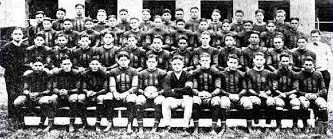
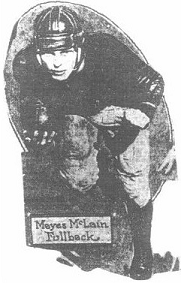 As previously discussed:
Haskell was tied by 6-0-2 Boston College, a minor team that also tied
7-1-2 Holy Cross (who lost to Boston and tied Fordham). Haskell rolled
up huge numbers, leading the nation with 558 points, but they beat no
one of value.
As previously discussed:
Haskell was tied by 6-0-2 Boston College, a minor team that also tied
7-1-2 Holy Cross (who lost to Boston and tied Fordham). Haskell rolled
up huge numbers, leading the nation with 558 points, but they beat no
one of value.
Haskell is now known as Haskell Indian Nations, but at this time it
was Haskell Institute. It is a Native American school located in
Lawrence, Kansas. They largely played lower-division type schedules,
but they played and defeated major teams now and then in the early part
of the 20th century, and we will see Haskell in a top 25 at some point
as I move backward in time.
The coach this year was Dick Hanley,
who played quarterback for Washington State 1915-1917 and 1919. He had
been a high school coach in Oregon 1920-1921, winning a pair of state
championships, and then he went a terrific 52-9-4 at Haskell 1922-1926.
After that, Northwestern hired him away, and he fielded some powerful
teams as he went 36-26-4 there 1927-1934, but his last 3 years were
losing seasons.
Haskell was playing in a new $185,000 stadium
this year, funded by tribes across the nation. The star of the team was
fullback Mayes McLain (pictured at left). He played 1925-1926, then
played for Iowa in 1928. This year he scored a record 235 points on 38
touchdowns, 19 extra points, and 2 field goals. He later became a
wrestler, performing under the name "Masked Manager" 1933-1953. It is
interesting to note that McLain was out with an injury for the BC game,
Haskell's only tie. He is in the American Indian Athletic Hall of Fame,
which is housed at Haskell.
Haskell played a postseason game
against the Hawaii All Stars, a club team, in San Francisco on December
18th. They trained before the game at Stanford (10-0-1, #6), and they
played a scrimmage against Stanford's team, which was preparing for the
Rose Bowl, and Haskell won the scrimmage.
Southern Methodist 8-0-1
As previously discussed:
Southern Methodist was tied by 5-1-2 Missouri (covered next). They beat
6-1-2 Texas Christian 14-13 at home in their finale to win the
Southwest, but that score does them few favors, as TCU was tied by
6-3-1 Baylor and 5-3-1 Texas A&M, and they struggled to get by
Daniel Baker 5-3 and Austin 7-0. Baylor lost to St. Edward's (Texas),
and A&M lost to 5-4 Texas. Texas lost to 5-3 Kansas State. So the
whole Southwest was rather weak. SMU's other weak wins, 9-7 over Texas
A&M at home and 21-17 at Texas, were therefore all the more
egregious.
Missouri 5-1-2
As previously discussed:
Missouri won 14-7 at #25 Nebraska (6-2), and they tied 8-0-1 SMU
(covered above), and those are some great results, but they also tied
3-5-1 Tulane at home and lost to 5-2-1 Oklahoma (who lost to Kansas and
Kansas State, and tied Oklahoma State). Back on the plus side, they
beat a good (but unrated) 6-4 West Virginia team 27-0, but that was one
week after edging a poor 4-3-1 Iowa State 7-3. This was an up and down
team, as you can see. They should be rated behind Nebraska and SMU, and
ahead of Tulane and Oklahoma, where their good results are balanced out
by their bad results.
Columbia 6-3
Columbia's losses came to #9 Ohio State, #20 Penn, and #15
Syracuse. Their one big win was 17-9 over 6-1-1 Cornell (covered
below). They were weak in a 13-10 win over 7-3 minor team William &
Mary.
Cornell 6-1-1
As previously discussed:
Cornell lost to Columbia (covered above), and should be rated behind
them, but Cornell also tied #20 Penn 10-10 on the road. They were weak
in wins by 6-0 over 8-3 minor team Geneva and by 24-23 over 4-4
Dartmouth.
Tennessee 8-1
Tennessee lost
20-3 at 8-1 Vanderbilt (covered above). They had 3 weak performances,
14-7 at 6-3 LSU (lost to 5-4 Mississippi State, who was crushed by 3-5
Indiana), 6-0 over 7-3 minor team Maryville, and 6-0 over 2-6-1
Kentucky. They may not really merit making this list, but this was the
first season for the greatest coach in Tennessee football history,
Robert Neyland, so I'm listing them.
Wisconsin 5-2-1
Wisconsin
lost 16-10 to #18 Minnesota and they were embarrassed 37-0 by #2
Michigan. Their tie came to 5-2-1 Purdue (covered next) 0-0 on the
road. They had no win of value, and struggled past 2-6 Chicago 14-7 in
their finale.
Purdue 5-2-1
Purdue
lost a very close 17-13 game at #1 Navy in their opener, but they did
not continue to perform at that level. They lost 22-0 to #10
Northwestern, and they tied Wisconsin (covered above). They had a pair
of weak performances in wins, 21-14 over 5-4 minor team Wabash and 6-0
at 2-6 Chicago, and they had no win of value.
Gonzaga 5-2-1
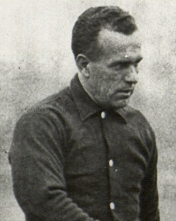
Gonzaga
lost 23-6 to #22 Oregon State and 7-0 to #23 Washington State. They
tied 9-0-1 St. Mary's (covered above). They rolled up huge scores in 4
of their wins, but played ill in a 10-6 win over 3-5 Montana at home.
Gonzaga
had no real football history, but they were close to top 25 worthiness
this season, and they had an excellent head coach, Maurice "Clipper"
Smith (pictured above). Smith had played guard for Knute Rockne at
Notre Dame 1917-1920. He went 23-9-5 at Gonzaga 1925-1928, then he
built Santa Clara into a nationally known power with a 38-22-4 record
1929-1935. Next was a strong 41-17-3 effort at Villanova 1936-1942.
Overall he was 109-75-12, always at difficult places to win, and it is
surprising that he is not in the Hall of Fame, while a loser like Tuss
McLaughry (see Brown above) is.
Utah 7-0
Utah
ruled the weak-to-the-point-of-irrelevant Rocky Mountain region, with
just one close game, 10-6 over 6-2-1 Colorado State at home. Their best
win came 34-0 over 5-1-2 Utah State.
Loyola-New Orleans 10-0
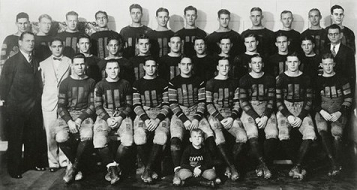
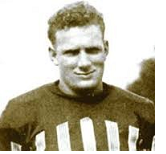 Loyola-New
Orleans was a huge sensation in their hometown, but unfortunately no
one paid much attention in the rest of the country, largely because
their schedule was comparable to lower-division play today. They did
win 13-10 at 6-3-1 Baylor, but Baylor was not a top 50 team, so the
score doesn't help much, and Baylor was the only major team they
played. Loyola's performance was impressive overall, as they outscored
their opponents 415-30, but they had another close win, 6-0 over
Catholic, so they are really not much of a candidate for the top 25.
Still, they might have been good enough that they could have earned a
spot if given the chance.
Loyola-New
Orleans was a huge sensation in their hometown, but unfortunately no
one paid much attention in the rest of the country, largely because
their schedule was comparable to lower-division play today. They did
win 13-10 at 6-3-1 Baylor, but Baylor was not a top 50 team, so the
score doesn't help much, and Baylor was the only major team they
played. Loyola's performance was impressive overall, as they outscored
their opponents 415-30, but they had another close win, 6-0 over
Catholic, so they are really not much of a candidate for the top 25.
Still, they might have been good enough that they could have earned a
spot if given the chance.
The
coach was Eddie Reed, who had played next door for Tulane 1919-1922.
After this 10-0 outing, that was it for him, at least for a while, as
Hall of Fame coach Clark Shaughnessy was lured to Loyola from Tulane.
Reed coached again 1935-1936, but the magic was gone, and he only went
6-12-1 in that stint.
Still, this season was better than any
that Shaughnessy managed at Loyola, though the thanks goes to the
team's star back, William Elton "Bucky" Moore (pictured at left),
"The Dixie Flyer." Bucky Moore rushed for 1304 yards this season and
scored 14 touchdowns and 21 extra points.
1926
Top 25
1) Navy 9-0-1
2) Michigan 7-1
3) Notre Dame 9-1
4) Army 7-1-1
5) Lafayette 9-0
6) Stanford 10-0-1
7) Alabama 9-0-1
8) Southern Cal 8-2
9) Ohio State 7-1
10) Northwestern 7-1
11)
Washington & Jefferson 7-1-1
12) Carnegie 7-2
13) Pittsburgh 5-2-2
14) Georgetown 7-2-1
15) Syracuse 7-2-1
Colgate 5-2-2
Brown 9-0-1
18) Minnesota 5-3
19) Illinois 6-2
20) Pennsylvania 7-1-1
21) New York 8-1
22) Oregon State 7-1
23) Washington State 6-1
24) Washington 8-2
25) Nebraska 6-2
Others
Receiving Votes:
Vanderbilt 8-1
St. Mary's (California) 9-0-1
Haskell 12-0-1
Southern Methodist 8-0-1
Missouri 5-1-2
Columbia 6-3
Cornell 6-1-1
Tennessee 8-1
Wisconsin 5-2-1
Purdue 5-2-1
Gonzaga 5-2-1
Utah 7-0
Loyola (New Orleans) 10-0

 Brown
and Columbia are the only schools now in the Ivy League that never won
a mythical national championship. Brown tended to be strong until World
War I, but they rarely threatened to be best in the land. They were more
of a #15 type team, going 98-52-6 against fairly rigorous schedules
1902-1917.
Brown
and Columbia are the only schools now in the Ivy League that never won
a mythical national championship. Brown tended to be strong until World
War I, but they rarely threatened to be best in the land. They were more
of a #15 type team, going 98-52-6 against fairly rigorous schedules
1902-1917.




 As previously discussed
As previously discussed

 Loyola-New
Orleans was a huge sensation in their hometown, but unfortunately no
one paid much attention in the rest of the country, largely because
their schedule was comparable to lower-division play today. They did
win 13-10 at 6-3-1 Baylor, but Baylor was not a top 50 team, so the
score doesn't help much, and Baylor was the only major team they
played. Loyola's performance was impressive overall, as they outscored
their opponents 415-30, but they had another close win, 6-0 over
Catholic, so they are really not much of a candidate for the top 25.
Still, they might have been good enough that they could have earned a
spot if given the chance.
Loyola-New
Orleans was a huge sensation in their hometown, but unfortunately no
one paid much attention in the rest of the country, largely because
their schedule was comparable to lower-division play today. They did
win 13-10 at 6-3-1 Baylor, but Baylor was not a top 50 team, so the
score doesn't help much, and Baylor was the only major team they
played. Loyola's performance was impressive overall, as they outscored
their opponents 415-30, but they had another close win, 6-0 over
Catholic, so they are really not much of a candidate for the top 25.
Still, they might have been good enough that they could have earned a
spot if given the chance.